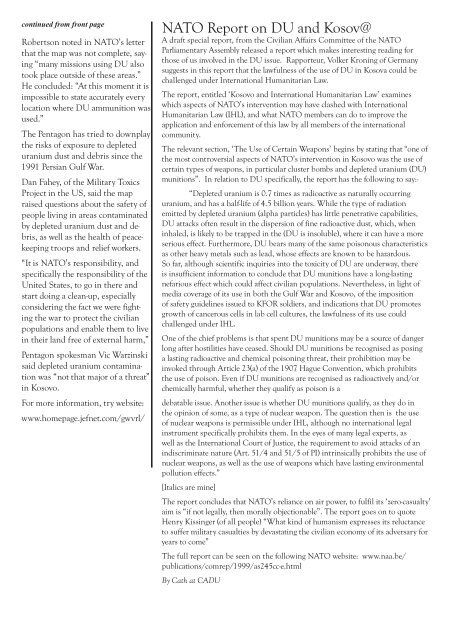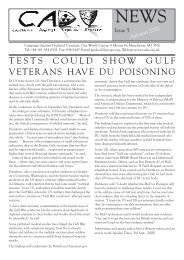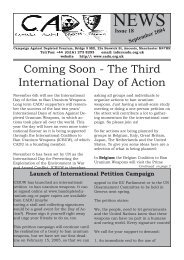CADU News 4 - Campaign Against Depleted Uranium
CADU News 4 - Campaign Against Depleted Uranium
CADU News 4 - Campaign Against Depleted Uranium
You also want an ePaper? Increase the reach of your titles
YUMPU automatically turns print PDFs into web optimized ePapers that Google loves.
continued from front page<br />
Robertson noted in NATO’s letter<br />
that the map was not complete, saying<br />
“many missions using DU also<br />
took place outside of these areas.”<br />
He concluded: “At this moment it is<br />
impossible to state accurately every<br />
location where DU ammunition was<br />
used.”<br />
The Pentagon has tried to downplay<br />
the risks of exposure to depleted<br />
uranium dust and debris since the<br />
1991 Persian Gulf War.<br />
Dan Fahey, of the Military Toxics<br />
Project in the US, said the map<br />
raised questions about the safety of<br />
people living in areas contaminated<br />
by depleted uranium dust and debris,<br />
as well as the health of peacekeeping<br />
troops and relief workers.<br />
“It is NATO’s responsibility, and<br />
specifically the responsibility of the<br />
United States, to go in there and<br />
start doing a clean-up, especially<br />
considering the fact we were fighting<br />
the war to protect the civilian<br />
populations and enable them to live<br />
in their land free of external harm,”<br />
Pentagon spokesman Vic Warzinski<br />
said depleted uranium contamination<br />
was “not that major of a threat”<br />
in Kosovo.<br />
For more information, try website:<br />
www.homepage.jefnet.com/gwvrl/<br />
NATO Report on DU and Kosov@<br />
A draft special report, from the Civilian Affairs Committee of the NATO<br />
Parliamentary Assembly released a report which makes interesting reading for<br />
those of us involved in the DU issue. Rapporteur, Volker Kroning of Germany<br />
suggests in this report that the lawfulness of the use of DU in Kosova could be<br />
challenged under International Humanitarian Law.<br />
The report, entitled ‘Kosovo and International Humanitarian Law’ examines<br />
which aspects of NATO’s intervention may have clashed with International<br />
Humanitarian Law (IHL), and what NATO members can do to improve the<br />
application and enforcement of this law by all members of the international<br />
community.<br />
The relevant section, ‘The Use of Certain Weapons’ begins by stating that “one of<br />
the most controversial aspects of NATO’s intervention in Kosovo was the use of<br />
certain types of weapons, in particular cluster bombs and depleted uranium (DU)<br />
munitions”. In relation to DU specifically, the report has the following to say:-<br />
“<strong>Depleted</strong> uranium is 0.7 times as radioactive as naturally occurring<br />
uranium, and has a half-life of 4.5 billion years. While the type of radiation<br />
emitted by depleted uranium (alpha particles) has little penetrative capabilities,<br />
DU attacks often result in the dispersion of fine radioactive dust, which, when<br />
inhaled, is likely to be trapped in the (DU is insoluble), where it can have a more<br />
serious effect. Furthermore, DU bears many of the same poisonous characteristics<br />
as other heavy metals such as lead, whose effects are known to be hazardous.<br />
So far, although scientific inquiries into the toxicity of DU are underway, there<br />
is insufficient information to conclude that DU munitions have a long-lasting<br />
nefarious effect which could affect civilian populations. Nevertheless, in light of<br />
media coverage of its use in both the Gulf War and Kosovo, of the imposition<br />
of safety guidelines issued to KFOR soldiers, and indications that DU promotes<br />
growth of cancerous cells in lab cell cultures, the lawfulness of its use could<br />
challenged under IHL.<br />
One of the chief problems is that spent DU munitions may be a source of danger<br />
long after hostilities have ceased. Should DU munitions be recognised as posing<br />
a lasting radioactive and chemical poisoning threat, their prohibition may be<br />
invoked through Article 23(a) of the 1907 Hague Convention, which prohibits<br />
the use of poison. Even if DU munitions are recognised as radioactively and/or<br />
chemically harmful, whether they qualify as poison is a<br />
debatable issue. Another issue is whether DU munitions qualify, as they do in<br />
the opinion of some, as a type of nuclear weapon. The question then is the use<br />
of nuclear weapons is permissible under IHL, although no international legal<br />
instrument specifically prohibits them. In the eyes of many legal experts, as<br />
well as the International Court of Justice, the requirement to avoid attacks of an<br />
indiscriminate nature (Art. 51/4 and 51/5 of PI) intrinsically prohibits the use of<br />
nuclear weapons, as well as the use of weapons which have lasting environmental<br />
pollution effects.”<br />
[Italics are mine]<br />
The report concludes that NATO’s reliance on air power, to fulfil its ‘zero-casualty’<br />
aim is “if not legally, then morally objectionable”. The report goes on to quote<br />
Henry Kissinger (of all people) “What kind of humanism expresses its reluctance<br />
to suffer military casualties by devastating the civilian economy of its adversary for<br />
years to come”<br />
The full report can be seen on the following NATO website: www.naa.be/<br />
publications/comrep/1999/as245cc-e.html<br />
By Cath at <strong>CADU</strong>





